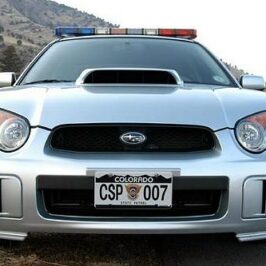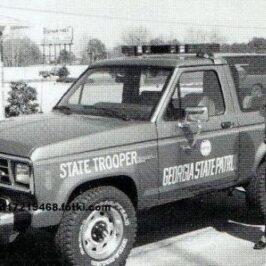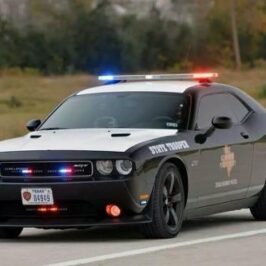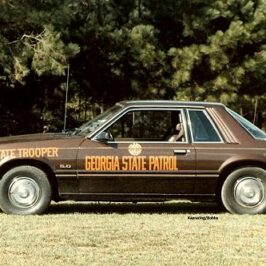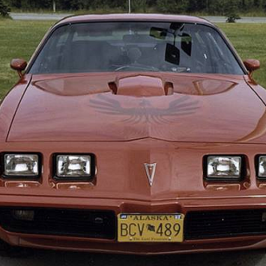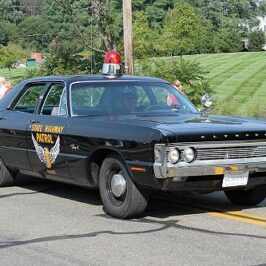While many state police and highway patrol agencies liked the big Dodges, the Ohio State Highway Patrol (OSHP) drove Plymouths instead. The OSHP didn’t start driving Dodges until 2012 after Ford stopped offering the Crown Victoria. Some of the Plymouths the OSHP drover were:
- 1967 Plymouth Fury
- 1970 Plymouth Fury
- 1972 Plymouth Fury
- 1975 Plymouth Fury
- 1978 Plymouth Fury
- 1981 Plymouth Gran Fury
- 1984 Plymouth Gran Fury
- 1986 Plymouth Gran Fury
The 1975 Plymouth Gran Fury you see here was originally a North Carolina Highway Patrol car put into service from 1975-1978 and has a 440 “Super Commando” police rated engine. It has been restored to represent what the Ohio State Highway Patrol cars looked like for the United States bicentennial in 1976. For this occasion, the cars received red and blue diagonal stripes on the front fenders for a red / white / blue scheme. This would be the only time that the cars had stripes on them until the OSHP celebrated its 60th anniversary in 1993.
Below are some photos of actual OSHP cars with the bicentennial stripes on the fenders. It’s interesting that the car below doesn’t have any antennas on it. It would appear that someone at General Headquarters took photos of it before the radio technicians installed the radios.
Not all cars had a beacon on the roof. Some were slick tops with red stationary lights mounted on the front fenders and inside the rear window. Another interesting fact is that in 1976 the OSHP changed from using ‘Patrolman’ to ‘Trooper’ after hiring the first female. The cars now had ‘State Trooper’ on the rear instead of ‘State Patrol’.
The car you see here has five ‘lightning bolts’ on the driver’s door. This is part of the ‘Blue Max’ auto larceny program that was started in 1972 and continues today. Whenever a Trooper arrests someone driving a stolen vehicle, they get a lightning bolt to display on their door. If they receive five lightning bolts in a calendar year, they earn the title of ‘Ace’ and receive a blue and white uniform ribbon and an ‘Ace’ license plate for their patrol car. Whoever got the most stolen vehicles in a calendar year was given the title of ‘Blue Max’. Each year the lightning bolt colors switched between blue and red.
The idea of an ‘Ace’ goes back to WWI & WWII when fighter pilots earned the title of ‘Ace’ or ‘Flying Ace’ for shooting down five or more enemy aircraft, and pilots would put the enemy’s symbol (German Cross, Japanese Zero, etc) on the outside of their cockpit.
You’ll also notice that this car has an MR7 RADAR that the OSHP began using in 1972 and a Unity RV46 beacon with a spitfire dome. The dome is called a ‘spitfire’ because of the two clear bands that allow white light to pass through. The actual beacon should be a Unity RV26 which has two bulbs instead of four. The RV26 beacons have been used by the Michigan State Police for a very long time but were rare for the OSHP. The OSHP only used them in 1975 & 1976. In 1977 the OSHP switched to the Yankee 911 full width lightbar.
The ‘CB CH9’ license plate is not accurate. These license plates weren’t used until 1977. With the popularity of CB Radios, the Ohio State Highway Patrol added CB radios to their patrol cars with the license plate CB CH9. If you were travelling down the interstate and needed help, you could call for the highway patrol on channel 9 of your CB. The highway patrol post also had a CB base station that the dispatchers monitored as well.
in 1993 with the growing popularity of cell phones, the OSHP replaced the CB CH9 plates with license plates that read ‘1-800-GRAB-DUI’.
In case you’re wondering, Ohio State Highway Patrol cars were black from 1933 to 1966. In 1966 the OSHP began using a few white patrol cars in special tactical squads that were assigned to areas with high crash rates. In 1971 the OSHP switched to all white patrol cars. Since then, they have also used silver and gray.
For more information on the history of Ohio State Highway Patrol Cars, check out:
History of Ohio State Highway Patrol Vehicles
About The Author
Code 3 Garage
I started my career as a police officer in 1989 with the Geneva on The Lake Police Department. I worked part time as a police officer and full time as a Security Sergeant doing armed mobile security patrols for a local security company. In 1990 I became a State Trooper with the Ohio State Highway Patrol. During my career as a State Trooper I was certified as a Technical Crash Investigator, OPOTA Police Instructor, OPOTA Police Driving Instructor, LASER Instructor, and received awards for ACE (Auto Larceny) and Post Trooper of The Year. Code 3 Garage is a mix of my inner automotive gearhead, and public safety background. I hope you enjoy it!













